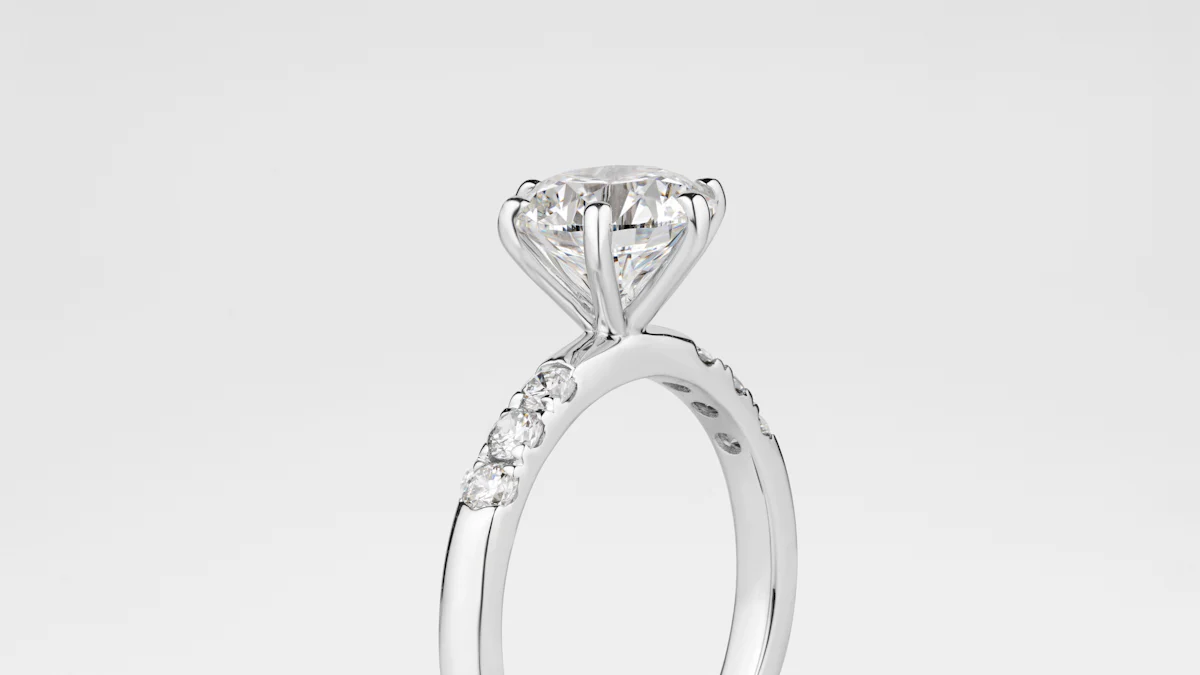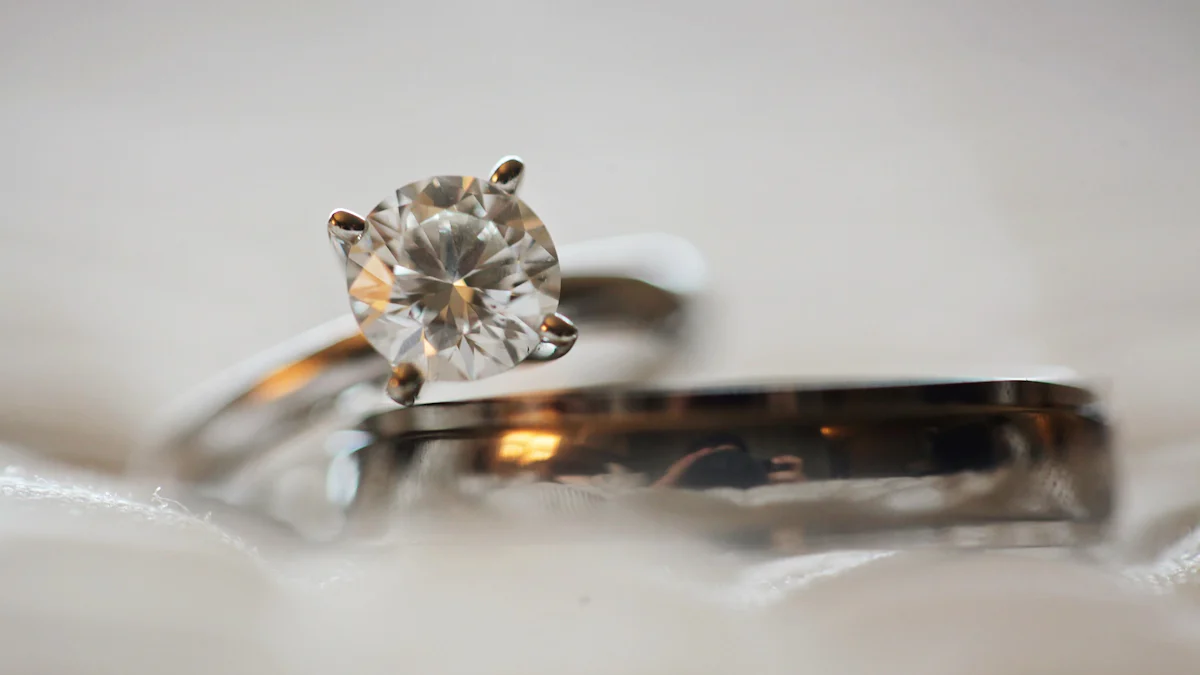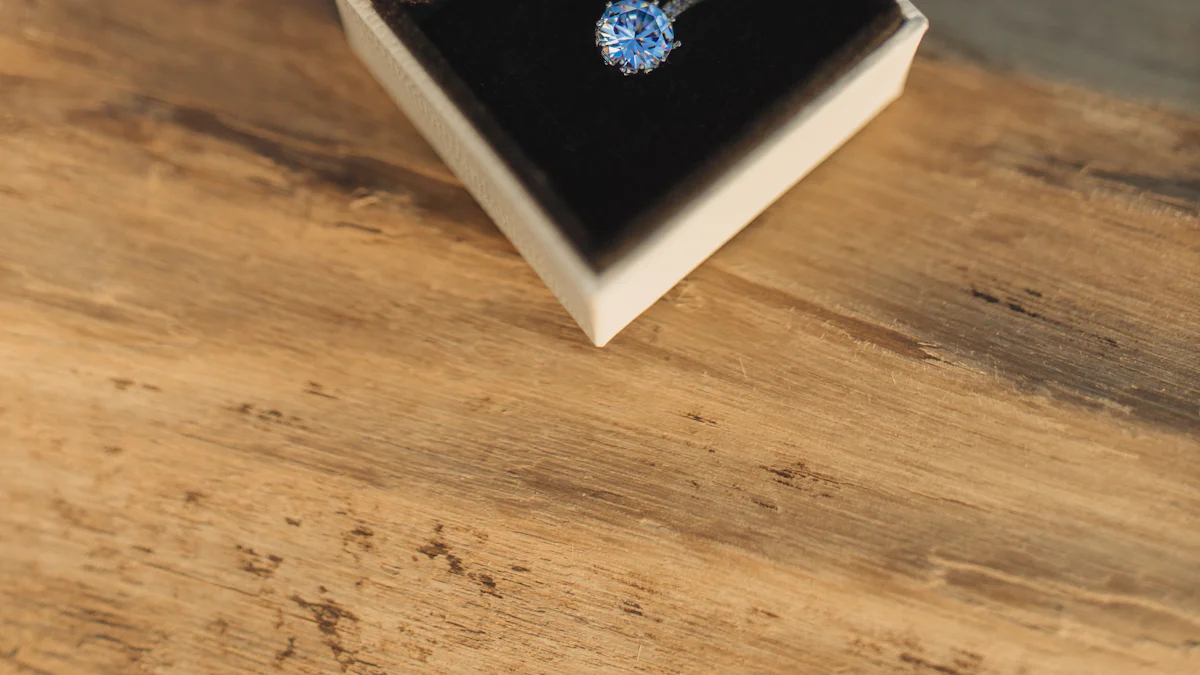Tips for Buying a Two Carat Solitaire Diamond Ring

Choosing the perfect two carat solitaire diamond engagement ring is a big decision. You want something timeless, versatile, and stunning. A solitaire setting highlights the diamond’s natural beauty, making it the star of the show. It’s a classic choice that works for any occasion. Whether you’re drawn to its elegance or its ability to showcase a natural diamond engagement ring, this style never goes out of fashion. By focusing on quality and understanding what matters most, you’ll feel confident in your choice.
Understanding the 4Cs of a 2 Carat Diamond

When buying a 2 carat diamond, understanding the 4Cs of diamond quality—cut, color, clarity, and carat weight—is essential. These factors determine the beauty and value of your diamond. Let’s break them down to help you make the best choice.
Cut: The Key to Brilliance
The cut of a diamond is the most important factor for its sparkle. It’s all about how the diamond’s facets are arranged to reflect light. A well-cut diamond maximizes brilliance, fire, and scintillation, making it truly eye-catching. On the other hand, a poor cut can dull its shine, even if the diamond is large.
Here’s what you should know:
- A shallow cut may make the diamond look bigger but reduces its sparkle.
- A deep cut can make it appear smaller and darker.
- A well-proportioned diamond reflects light beautifully, creating that dazzling effect you’re looking for.
To ensure you’re getting the best, prioritize the cut. Look for diamonds graded as Excellent or Very Good by the GIA or AGS. These grades guarantee a diamond with exceptional brilliance and visual appeal.
Color: Balancing Beauty and Budget
The color of a diamond refers to how white or colorless it appears. For a 2 carat diamond, the most popular color grades fall between D and H. Diamonds in this range offer a bright, icy-white sparkle that looks stunning in any setting. Lower grades, like J or below, may show a slight yellow tint, which some people prefer for its warmth.
If you’re balancing beauty and budget, consider an H-grade diamond. It provides a near-colorless appearance at a more affordable price. Remember, the larger the diamond, the more noticeable its color, so choose wisely.
Clarity: Choosing Eye-Clean Diamonds
Diamond clarity measures the presence of inclusions or blemishes. For a 2 carat diamond, clarity is crucial because larger diamonds make imperfections more visible. The good news? You don’t need a flawless diamond to achieve a stunning look.
Focus on clarity grades like VS2 or SI1. These are often “eye-clean,” meaning you won’t see any inclusions without magnification. This approach helps you save money while still getting a diamond that looks perfect to the naked eye.
By understanding these aspects of the 4Cs of diamond quality, you’ll be better equipped to find a 2 carat diamond that fits your style and budget.
Carat Weight: Why 2 Carats is a Popular Choice
When it comes to engagement rings, a 2 carat diamond strikes the perfect balance between size and practicality. It’s big enough to make a statement but not so large that it feels overwhelming or impractical for everyday wear. If you’re looking for a ring that turns heads without being too flashy, a 2-carat diamond might be just what you need.
One reason 2 carats is so popular is the visual impact. A diamond of this size has a noticeable presence on the finger, making it a showstopper in any setting. Whether you choose a round, oval, or emerald cut, the 2 carat diamond offers a stunning display of brilliance and fire. It’s the kind of size that gets compliments without you even trying.
Another reason people love this size is its versatility. A 2-carat diamond works beautifully in a variety of settings, from classic solitaires to more intricate designs. It’s large enough to stand out on its own but also pairs well with accent stones or a halo setting if you want extra sparkle.
You’ll also find that a 2 carat diamond offers great value. It’s a sweet spot where you can get a significant size without jumping into the much higher price brackets of 3 carats or more. By focusing on the other 4Cs—like cut and clarity—you can maximize the beauty of your diamond while staying within your budget.
Ultimately, a 2-carat diamond is a timeless choice. It’s bold yet elegant, making it a favorite for those who want a ring that feels both luxurious and wearable. If you’re after a diamond that checks all the boxes, this size is hard to beat.
Choosing the Best Shape for a Diamond Engagement Ring
When it comes to picking the perfect diamond shape, you’ve got plenty of options. The shape you choose can completely change the look and feel of your engagement ring. Whether you prefer something timeless or want to show off your unique style, there’s a shape that’s just right for you.
Classic Shapes for Solitaire Rings
If you’re drawn to a traditional look, classic diamond shapes are the way to go. These shapes have stood the test of time and continue to be popular for solitaire rings. Here are some of the most common choices:
- Round diamonds: Known for their brilliant sparkle and timeless appeal, round diamonds are the most sought-after shape. Their symmetrical design maximizes light reflection, giving you unmatched brilliance.
- Princess-cut diamonds: With their sharp edges and square shape, princess cuts offer a modern, geometric look. They’re perfect if you want something sleek and contemporary.
- Oval diamonds: These have an elongated silhouette that’s both elegant and flattering. They can even make your fingers look slimmer!
- Cushion diamonds: Featuring rounded corners and a soft, pillow-like shape, cushion cuts combine vintage charm with a trendy vibe.
- Emerald and pear shapes: Both offer unique styles. Emerald cuts have a sophisticated, step-cut design, while pear shapes resemble a teardrop for a romantic feel.
Classic shapes like these are versatile and work beautifully in solitaire settings. They’re perfect if you want a timeless look that never goes out of style.
Unique Shapes to Match Personal Style
If you’re looking for something that reflects your personality, unique diamond shapes might be the answer. These shapes stand out and add a touch of individuality to your custom engagement ring. Here’s a quick guide to some distinctive options:
| Diamond Shape | Description | |---------------|-----------------------------------------------------------------------------| | Asscher | A square shape with deep cut corners, ideal for art deco-inspired designs. | | Marquise | An elongated shape with pointed ends, creating the illusion of a larger size.| | Pear | A teardrop shape that feels romantic and one-of-a-kind. | | Cushion | Rounded edges give it a soft, vintage look that’s always in style. |
Unique shapes like these can make your ring feel extra special. Plus, some shapes, like marquise or oval, can even make a two-carat diamond appear larger due to their elongated design. If you want a ring that’s as unique as your love story, these shapes are worth considering.
Choosing the right diamond shape is all about finding what speaks to you. Whether you go for a classic round or a bold pear shape, the right choice will make your engagement ring truly unforgettable.
Selecting the Right Setting for a Two Carat Solitaire Diamond Engagement Ring

Popular Solitaire Settings
The setting of your ring plays a big role in how your diamond looks and how secure it stays. For a two carat solitaire diamond, some settings stand out for their beauty and practicality.
- Prong Setting: This is the most classic choice. It uses small metal claws to hold the diamond in place. The prongs allow maximum light to pass through the diamond, making it sparkle brilliantly.
- Tiffany Setting: Known for its timeless elegance, this setting lifts the diamond above the band, showcasing it prominently.
- Bezel Setting: If you have an active lifestyle, this modern option is perfect. A metal rim surrounds the diamond, keeping it safe from bumps and scratches.
- Halo Setting: While not a true solitaire, this style adds a circle of tiny diamonds around the main stone. It enhances the size and brilliance of your diamond.
Each setting has its own charm. If you want a traditional look, go for prongs or the Tiffany setting. For something more secure, the bezel setting is a great choice.
Choosing the Best Metal for the Band
The metal you choose for your band affects both the look and durability of your ring. Popular options include white gold, yellow gold, rose gold, and platinum. Each offers unique qualities.
- Platinum: This is a top choice for solitaire rings. It’s durable, hypoallergenic, and keeps its shine without needing re-plating. Its strength ensures your diamond stays secure.
- White Gold: This metal gives a sleek, modern look. It’s more affordable than platinum but may need occasional re-plating to maintain its shine.
- Yellow Gold: A classic option that adds warmth and a vintage feel to your ring.
- Rose Gold: Perfect if you want a romantic and trendy style.
Platinum is ideal if you want a luxurious and long-lasting band. For a more budget-friendly option, white gold is a great alternative. The metal you pick should complement your diamond and match your personal style.
Balancing Quality and Budget for a 2 Carat Diamond
Smart Ways to Save Without Compromising Quality
Finding the perfect 2 carat diamond doesn’t mean you have to break the bank. With a few smart strategies, you can balance quality and budget while still getting a stunning stone.
- Consider fancy shapes: Round diamonds are beautiful but often the most expensive. Shapes like pear, oval, or cushion can cost 20-30% less while offering the same carat weight.
- Be flexible with color and clarity: Diamonds in the J or K color range and VS2 or SI1 clarity grades can look just as beautiful as higher grades. These options are more affordable and still appear eye-clean and near-colorless.
- Choose the best cut you can afford: The cut has the biggest impact on a diamond’s brilliance. Even with a lower color or clarity grade, a well-cut diamond will shine brightly.
- Buy just under 2 carats: A diamond that’s slightly below 2 carats, like 1.9 carats, can save you a significant amount while looking nearly identical in size.
- Shop during off-peak seasons: Certain times of the year may offer better deals or discounts, so keep an eye out for sales.
These tips can help you maximize your budget without sacrificing the beauty of your diamond.
Prioritizing the Most Important Factors
When balancing quality and budget, it’s essential to focus on what matters most. The 4Cs—cut, color, clarity, and carat—should guide your decision, but not all are equally important.
| Priority | Characteristic | Why It Matters | |----------|----------------|----------------| | 1 | Cut | A high-quality cut enhances brilliance and sparkle, making it the most critical factor. | | 2 | Color | A near-colorless diamond (G-H range) looks bright and beautiful without a premium price. | | 3 | Clarity | Eye-clean diamonds (VS2 or SI1) offer great value without visible imperfections. | | 4 | Carat | Size is important, but balancing it with the other 3Cs ensures the best overall value. |
Always prioritize the cut above everything else. A well-cut diamond will outshine a larger or higher-grade stone with poor proportions. Next, aim for a diamond that appears white to the naked eye and has no visible inclusions. By focusing on these factors, you’ll get the most value within your price range.
💡 Pro Tip: Don’t fall for the misconception that skipping a jeweler saves money. A trusted jeweler can guide you to the best deals and ensure you’re getting a high-quality diamond for the right price.
Balancing quality and budget is all about making informed choices. Stick to what’s most important to you, and you’ll find a diamond that’s both beautiful and within your price range.
Avoiding Common Mistakes When Buying a Diamond Engagement Ring
Importance of Certification and Grading Reports
When buying a diamond engagement ring, always check for certification. A certificate from a trusted gemological institute ensures the diamond is real and matches the seller’s claims. This is especially important if you’re shopping online, where scams are more common. Certification also helps you understand the diamond’s quality and ensures you’re paying a fair price.
Not all certifications are equal, though. Reputable labs like GIA (Gemological Institute of America) and AGS (American Gem Society) are known for their strict grading standards. IGI and HRD are also reliable, especially for lab-grown diamonds. Always verify that the diamond comes with a certificate from one of these trusted organizations. This step guarantees you’re getting what you pay for.
Considering Lighting Conditions When Viewing Diamonds
Lighting can dramatically change how a diamond looks. Its facets act like tiny mirrors, reflecting the environment and light around it. For example, under fluorescent lighting, a diamond might appear brighter, while spot lighting can enhance its fire and sparkle. Even your clothing’s color can affect how the diamond looks.
When viewing a diamond engagement ring, check it under different lighting conditions. Move it around and observe how it interacts with light. This will give you a better idea of its brilliance and overall appearance. Don’t rely on just one type of lighting, as it might not reflect how the diamond will look in everyday settings.
Buying Only from Reputable Jewelers
Choosing a reputable jeweler is crucial. Unverified sellers often provide inaccurate grading or sell diamonds without proper certification. While uncertified diamonds might seem cheaper, they often come with hidden issues. You could end up overpaying for a diamond of lower quality.
Stick to jewelers with a strong reputation and positive reviews. Trusted sellers will provide certified diamonds and guide you through the buying process. They’ll also ensure you’re getting a high-quality diamond engagement ring that matches your expectations. Taking this step protects your investment and gives you peace of mind.
Buying a two carat solitaire diamond engagement ring is a big decision, but understanding the essentials makes it easier. Remember the 4Cs: focus on a great cut for brilliance, choose a near-colorless color grade, pick eye-clean clarity, and balance carat weight with your budget. Select a shape and setting that reflect your style, and don’t forget the importance of certification. Always buy from a trusted jeweler to ensure quality. Take your time, research thoroughly, and prioritize what matters most to you. This way, you’ll find a natural diamond engagement ring that’s perfect for your love story.
FAQ
What is the best shape for a two-carat solitaire diamond?
The best shape depends on your style. Round diamonds are timeless and brilliant, while oval or pear shapes offer a unique, elegant look. Fancy shapes like cushion or marquise can also make the diamond appear larger. Choose what feels right for you!
How much should I budget for a two-carat diamond ring?
A two-carat diamond ring can range from $10,000 to $50,000 or more, depending on quality. Focus on the 4Cs—cut, color, clarity, and carat weight—to balance beauty and budget. Set a realistic budget and prioritize what matters most to you.
Are lab-grown diamonds a good option for a two-carat ring?
Yes! Lab-grown diamonds offer the same brilliance and durability as natural ones but at a lower cost. They’re also eco-friendly and conflict-free. If you want a stunning diamond without stretching your budget, lab-grown is worth considering.
How do I know if a diamond is certified?
Ask for a grading report from a trusted lab like GIA or AGS. The certificate should detail the diamond’s 4Cs and confirm its authenticity. Always verify the certification before purchasing to ensure you’re getting what you pay for.
Can I customize a two-carat solitaire diamond ring?
Absolutely! Many jewelers let you choose the diamond, setting, and metal to create a custom ring. This allows you to design a piece that reflects your style and preferences. Customization makes your ring truly one-of-a-kind.
See Also
A Comprehensive Approach to Selecting a White Diamond Ring
Ultimate Guide to Picking a Dual-Purpose Engagement and Wedding Ring
Essential Elements to Consider When Pricing Diamond Rings
Thorough Guide for Choosing the Ideal Diamond Ruby Ring
Selecting the Perfect Three-Stone Diamond Ring Featuring a Gold Band

